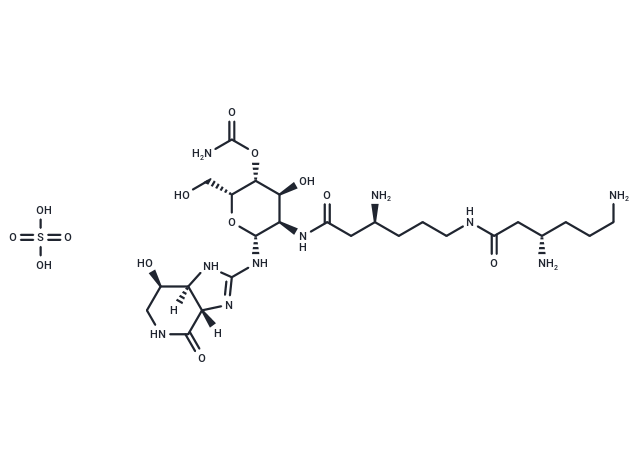Shopping Cart
- Remove All
 Your shopping cart is currently empty
Your shopping cart is currently empty

Nourseothricin sulfate (Streptothricin sulfate) is a broad-spectrum antibiotic that inhibits protein biosynthesis in prokaryotic cells and significantly impedes the growth of eukaryotes, including fungi.

| Pack Size | Price | Availability | Quantity |
|---|---|---|---|
| 5 mg | $41 | In Stock | |
| 10 mg | $66 | In Stock | |
| 25 mg | $113 | In Stock | |
| 50 mg | $172 | In Stock | |
| 100 mg | $277 | In Stock |
| Description | Nourseothricin sulfate (Streptothricin sulfate) is a broad-spectrum antibiotic that inhibits protein biosynthesis in prokaryotic cells and significantly impedes the growth of eukaryotes, including fungi. |
| In vivo | Renal handling of Nourseothricin is characterized in experiments on renal cortical slices under various experimental conditions.?Following administration in vivo the renal tubular transport system for organic anions (p-aminohippurate, PAH) is not influenced by Nourseothricin.?There is a high degree of accumulation of Nourseothricin in renal cortical slices.?In contrast to PAH accumulation there is no influence of nitrogen atmosphere, simultaneous administration of PAH, probenecid or trishydroxyaminomethane on Nourseothricin accumulation.?Age dependent differences in Nourseothricin accumulation does not exist[1]. |
| Alias | Streptothricin sulfate |
| Molecular Weight | 1359.47 |
| Formula | C50H94N20O22S |
| Cas No. | 96736-11-7 |
| Smiles | OS(O)(=O)=O.[H][C@]12NC(N[C@@H]3O[C@H](CO)[C@H](OC(N)=O)[C@@H](O)[C@H]3NC(=O)C[C@@H](N)CCCNC(=O)C[C@@H](N)CCCN)=N[C@]1([H])C(=O)NC[C@H]2O |
| Relative Density. | no data available |
| Storage | store at low temperature | Powder: -20°C for 3 years | In solvent: -80°C for 1 year | Shipping with blue ice. | |||||||||||||||||||||||||||||||||||
| Solubility Information | H2O: 250 mg/mL (183.90 mM), Sonication is recommended. | |||||||||||||||||||||||||||||||||||
Solution Preparation Table | ||||||||||||||||||||||||||||||||||||
H2O
| ||||||||||||||||||||||||||||||||||||

Copyright © 2015-2025 TargetMol Chemicals Inc. All Rights Reserved.